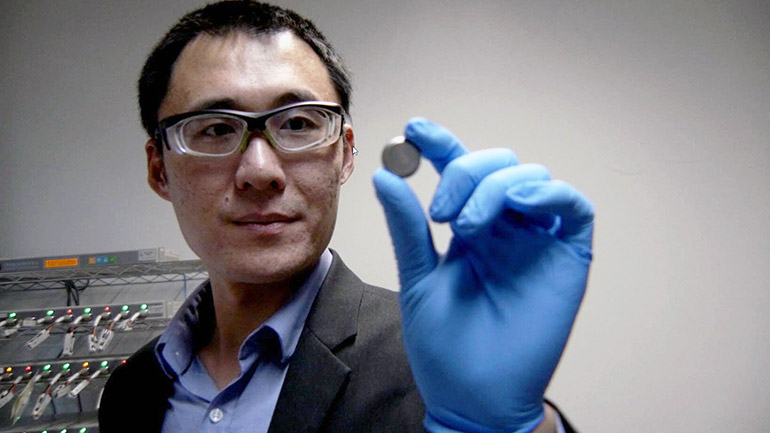
Dr. Jian Liu conducts research in materials and interface design for next-generation battery technologies.
UBCO professor works to create safe, energy-dense, renewable batteries
With increasing global efforts to adopt clean energy, developing sustainable storage systems has become a major challenge in getting electric vehicles on the road and integrating intermittent renewable energy resources into the grid.
Dr. Jian Liu is an assistant professor with UBC Okanagan's School of Engineering. He runs the Advanced Materials for Energy Storage Lab where he researches materials and interface design for next-generation battery technologies. His team of researchers is looking for ways to develop renewable technologies, contribute to the reduction of greenhouse gas emissions and increase public awareness and education of renewable energy.
Liu recently published a paper in the Journal of Power Sources about creating zinc-ion batteries. These zinc-ion batteries have shown the merits of intrinsic safety and high energy densities at low costs. He shares the science behind the basic battery, how batteries are evolving and the importance they have in today's technology.
In layperson terms, how does a battery work?
A battery works by moving electrons and ions back and forward between negative and positive electrodes via different paths. Electrons diffuse through external circuits to power up devices, while ions mitigate the energy inside the battery. During the charging process, electrons and ions move from the positive electrode to the negative electrode with energy stored and visa-versa during the discharge process with energy released.
We are all familiar with the batteries we use in our electronics and electric vehicles. How are batteries changing?
Over the past decades, we have witnessed the rapid adoption of rechargeable lithium-ion batteries in various applications, ranging from portable electronics to electric vehicles and grid storage. The dramatically increasing demand requires rechargeable batteries to be smaller, more energy-dense, safer and cheaper. And at the same time, this demand drives the current evolution in new battery chemistry, such as solid-state batteries, aqueous zinc-ion batteries, etc.
Are there other applications where batteries will soon become commonplace? For example, aviation?
Rechargeable batteries have been increasingly used in electric flights and marine applications to reduce carbon footprints. They are also used in wireless and intelligent devices, such as health monitoring sensors, Internet of Things and life-saving devices. Moreover, rechargeable batteries are popularly used in electric bicycles.
How is battery technology becoming more sustainable?
The development of efficient and cost-effective battery recycling processes is a key to close the loop for battery technology and make it sustainable. Current batteries use many elements with limited reserves, such as lithium, cobalt and nickel. Determining how to properly recycle the valued components from retired vehicle batteries is an urgent task to avoid potential adverse environmental impacts from battery disposal.
Currently, if you want batteries to hold a charge for longer, I recommend charging them at room temperature when the remaining battery level is about 20 per cent. This will also improve the lifetime of batteries, meaning they don't need to be recycled as often
What's the next big thing on the horizon?
The solid-state battery is one of the impending battery innovations on the horizon to bring breakthroughs in energy storage sectors. It will fundamentally address the safety issue associated with lithium-ion batteries, such as overheating or exploding, due to the use of solid electrolytes. This can potentially increase the driving range of electric vehicles beyond 500 Km per charge. Aqueous zinc-ion batteries are also promising safe and low-cost energy storage solutions for large-scale grid storage to meet the increasing need from intermittent renewable energy, such as wind and solar.
About UBC's Okanagan campus
UBC's Okanagan campus is an innovative hub for research and learning founded in 2005 in partnership with local Indigenous peoples, the Syilx Okanagan Nation, in whose territory the campus resides. As part of UBC-ranked among the world's top 20 public universities-the Okanagan campus combines a globally recognized UBC education with a tight-knit and entrepreneurial community that welcomes students and faculty from around the world in British Columbia's stunning Okanagan Valley.






